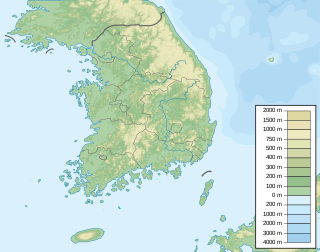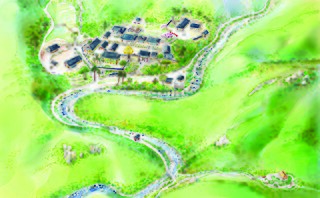Buddhist temples are an important part of the Korean landscape. This article gives a brief overview of Korean Buddhism, then describes some of the more important temples in Korea. Most Korean temples have names ending in -sa, which means "temple" in Sino-Korean.

Bulguksa is located on the slopes of Mount Toham. It is a head temple of the Jogye Order of Korean Buddhism and encompasses six National treasures of South Korea, including the Dabotap and Seokgatap stone pagodas, Cheongun-gyo, and two gilt-bronze statues of Buddha. The temple is classified as Historic and Scenic Site No. 1 by the South Korean government. In 1995, Bulguksa was added to the UNESCO World Heritage List together with the Seokguram Grotto, which lies four kilometers to the east.

Tongdosa is a head temple of the Jogye Order of Korean Buddhism and in the southern part of Mt. Chiseosan near Yangsan, South Gyeongsang Province, South Korea.

Pohyon-sa is a Korean Buddhist temple located in Hyangsan county in North Pyong'an Province, North Korea. It is located within the Myohyang Mountains. Founded under the Koryo dynasty at the start of the 11th century, the temple flourished as one of the greatest centers of Buddhism in the north of Korea, and became a renowned place of pilgrimage. Like most other temples in North Korea, the complex suffered extensive damage from US bombing during the Korean War. The temple is designated as National Treasure #40 in North Korea, with many of its component buildings and structures further declared as individual national treasures.

Jogyesa is the chief temple of the Jogye Order of Korean Buddhism. The building dates back to the late 14th century and became the order's chief temple in 1936. It thus plays a leading role in the current state of Seon Buddhism in South Korea. The temple was first established in 1395, at the dawn of the Joseon Dynasty; the modern temple was founded in 1910 and initially called "Gakhwangsa". The name was changed to "Taegosa" during the period of Japanese rule, and then to the present name in 1954.

Beopjusa is a head temple of the Jogye Order of Korean Buddhism. It is situated on the slopes of Songnisan, within Songnisan National Park, in Naesongni-myeon, Boeun County, in the province of Chungcheongbuk-do, South Korea.

Woljeongsa is a head temple of the Jogye Order of Korean Buddhism, located on the eastern slopes of Odaesan in Pyeongchang County, Gangwon Province, South Korea. Woljeongsa was founded in 643 by the Silla monk Jajang.

Seonunsa is a head temple of the Jogye Order of Korean Buddhism. It stands on the slopes of Dosolsan in Asan-myeon, Gochang County, near the Yellow Sea coast in western Jeollabuk-do province.

Hwaeomsa is a head temple of the Jogye Order of Korean Buddhism. It is located on the slopes of Jirisan, in Masan-myeon, Gurye County, in South Jeolla Province, South Korea.

Geumsansa is a temple of the Jogye Order of Korean Buddhism standing on the slopes of Moaksan in Gimje City, Jeollabuk-do, South Korea.

This refers to a pagoda containing the relics of Dabo Yeorae.

Palsangjeon is a worship hall found at a Korean Buddhist temple complex that contains the "Palsang", the series of painted murals depicting the eight stages in the life of the historic Buddha, Sakyamuni.

Bongjeongsa is a Korean Buddhist temple on the slopes of Mount Cheondeung in Andong city, North Gyeongsang Province, South Korea. It is a subsidiary temple of Gounsa, the head temple of the 16th branch of Jogye Order.

Tapsaand the Stone Pagodas of Mount Mai is a small Korean Buddhist Temple complex found in the Maisan in Jinan County, North Jeolla Province, South Korea.

Neunggasa is a Korean Buddhist temple located in Yeongnam-myeon township, Goheung-gun County, Jeollanam-do, South Korea.

Myogaksa Temple is a Korean Buddhist temple located in the heart of downtown Seoul, South Korea, in the Jongro District, nestled on the east side of Naksan Mountain. It houses the administrative headquarters of the Gwaneum Order of Korean Buddhism. It is located close to the Dongmangbong Peak, Naksan Park, Donggwanmyo Shrine and Dongdaemun Market.

Seonam Temple, or Seonamsa, is a Korean Buddhist temple on the eastern slope at the west end of Jogyesan Provincial Park, within the northern Seungjumyeon District of the city of Suncheon, South Jeolla Province, South Korea. It belongs to the Taego Order although the Jogye Order claims possession over it.

Buseoksa Temple is a Buddhist temple located near Mt. Bonghwang in Buseok-myeon, Yeongju City, Gyeongsangbuk-do, founded by the prominent scholar-monk Uisang in 676, the 16th year of Munmu of Silla. Buseoksa temple is also well known as the "Temple of the Floating Stone".

Naesosa, or Naeso Temple, is a Korean Buddhist Temple located at the base of Naebyeongsan (mountain) in Jinseo-myeon, (township), Buan-gun (county), Jeollabuk-do (province), South Korea.

Daewonsa is a Buddhist temple of the Jogye Order in Gyeongsangnam-do, South Korea.





































